If you’re either planning a trip to Rio de Janeiro or thinking about living there indefinitely, it’s very important to know more about the regions and districts in town. Although Rio is a small city if you compare it to São Paulo for example, it’s great to unite being near the touristic attractions and remain safe while doing so.
The best neighborhoods in Rio de Janeiro are mostly located in the city’s South Zone, which houses great districts such as Ipanema, Leblon, and Copacabana. But there also other great neighborhoods outside that area, like Tijuca, Recreio dos Bandeirantes, and Barra da Tijuca.
In today’s post, we’re gonna provide you with a full Rio de Janeiro neighborhood guide, showing you what are the best districts in the city. We’ll highlight all the best places to visit in each of them, as well as give you some pointers on where to eat, where to go to have fun, and also talk about some of the Rio de Janeiro neighborhoods to avoid.
1. Leblon
Leblon at a glance
Pros – near the beach, lots of close by restaurants and bars, easy to access
Cons – more expensive than most places in town
Best hotels –
Where to eat –
Where to drink –
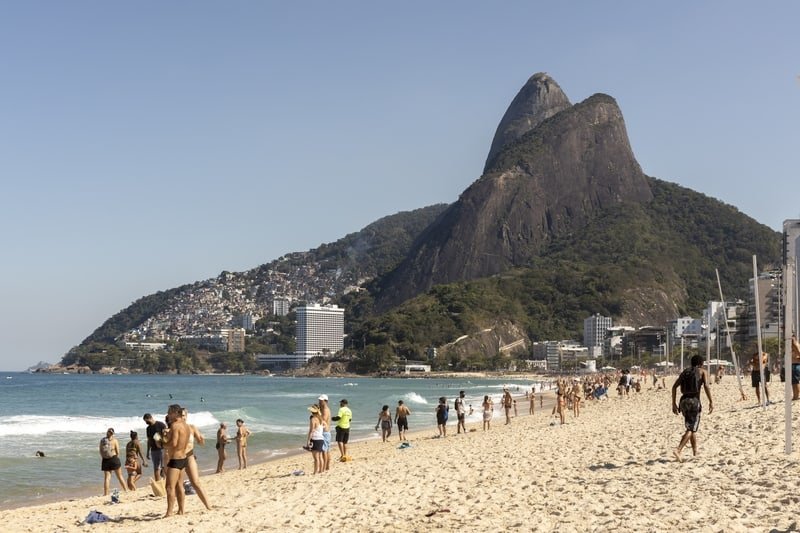
Leblon is the most valued neighborhood in Rio de Janeiro, located in the South zone of the city. The neighborhood is locally famous for being the home of many Brazilian artists like singers Chico Buarque and Adriana Calcanhoto, attracted by the district’s charming vibes and closeness to the beach.
Tourists often choose Leblon while looking for accommodations, as due to its location, the Leblon district is close to many touristic spots.
Leisure
There’s a lot to do in Leblon. Aside from sunbathing at the beach’s sand, you can head to Mirante do Leblon (the district’s observatory) to take some very instagrammable photos near the ocean, and even visit the Penhasco Dois Irmãos Park, where you can go trekking and play at the sports courts.
And if you want to know about more options of where you can go for the most intagrammable pictures in Rio de Janeiro, take a look at our video for the Top 6 Insta-worthy pictures!
Leblon is also very agitated at night, so there’s a lot to choose from in terms of bars and restaurants. The Bracarense and Belmonte bar are very traditional places to have a drink (both day and night), but if you’re looking for something a little fancier, maybe having a drink at the Janeiro Bar might be more up your alley.
Safety
Due to being located in the South Zone of Rio, the Leblon district is safer than other neighborhoods outside this area. Police force is contantly patroling the streets and since Leblon is fairly small, robbers tend to avoid acting in the neighborhood, as there isn’t many places to run and hide.
Gastronomy
Name what cuisine you’re in the mood to have and Leblon probably has the spot for you. The Artigiano Ristorante is one of the best Italian restaurants in the neighborhood, while in the Le Vin Bistrô Rio you’ll be able to enjoy some delicious French delicacies.
Now, if you’ve heard about our famous steakhouses (which we’ve written a delicious piece on, by the way), then Giuseppe Grill is the right call for you. But if you’re not in the mood for tons of meat, then head to Olivia Saladas Leblon and just pick which amazing salad you’ll be having.
Accessibility
Leblon can be easily accessed by either buses or the subway. The following bus lines are the most common around Leblon: 106 – TRO3, 2335, 460, 476, 553 – INT8, and 583.
The neighborhood has two subway stations, namely Jardim de Alah and Antero de Quental, both of them located in the far extremes of the district. This facilitates a lot when you need to use public transportation in Rio de Janeiro.
2. Ipanema
Ipanema at a glance
Pros – near the beach, lots of close by restaurants and bars, easy to access
Cons – more expensive than most places in town
Best hotels –
Where to eat –
Where to drink –
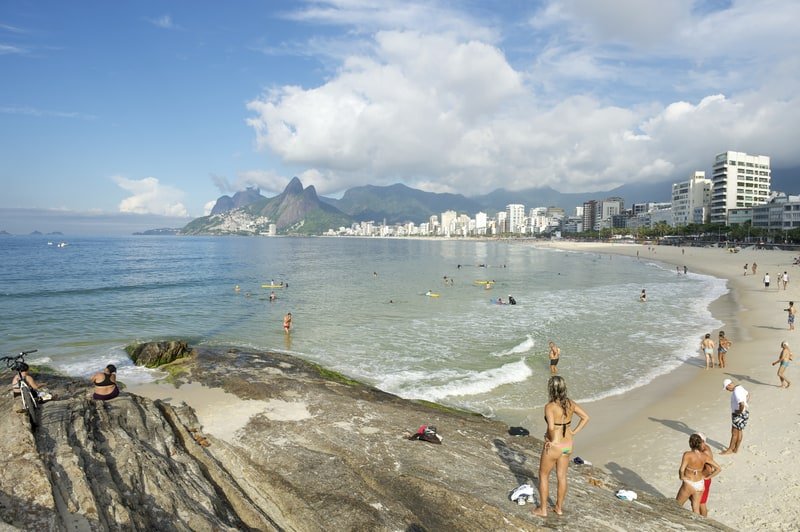
Leisure
Aside from attending one of the most famous beaches in the world (thanks to Tom Jobim and Vinicius de Moraes), you’ll most definetely enjoy the many outdoor activities Ipanema has to offer. You can visit the Feirinha Hippie (a local artisanal street market) for a little shopping or even take some great pictures at the Mirante da Paz observatory.
Despite living here my whole life, one of the things I still haven’t done in Leblon is visiting the Arquipélago de Cagarras, which is a conglomerate of small islands and reefs about 3 miles from the beach. Aside from many types of fish, you’ll also be able to sight dolphins, turtles, and even whales, depending on which time of the year you’re visiting.
Safety
Due to being located in the South Zone of Rio, the Ipanema district is safer than other neighborhoods outside this area. The police force is constantly patrolling the streets, and since Ipanema is surrounded by other safe neighborhoods (Lagoa, Leblon, and Copacabana), it’s usually also pretty safe.
But as a resident, I have to say: don’t let your guard down too much while roaming around in Rio de Janeiro, even in the safest districts! If you want to know more about how to be safe in the city, don’t forget to take a look at these tips for a safer trip we posted a while ago.
Gastronomy
Being the birthplace of Bossa Nova, expect a lot of small bars and pubs in Ipanema! The Garota de Ipanema bar is obviously a mandatory pit stop for those who want to know more about how the homonymous song was written (while enjoying an ice-cold draft beer).
In the restaurant department, there are tons of places to choose from! We went over almost every bar and restaurant in Ipanema in our Ultimate Ipanema Guide post, so definitely take a look if you’re interested in knowing what delicious meals you’ll be able to taste there!
Accessibility
Ipanema has a very privileged location, where you can easily go to Barra da Tijuca, other areas in the South Zone and to Rio de Janeiro’s Downtown area. There are buses that circulate around the south zone and are able to get you to other interesting places in the area, the most common lines being 106 – TRO3, 2334, 2335, 461, 552 – INT2, and 553 – INT8.
The Ipanema district also has 2 subway stations: the Jardim de Alah station (shared with Leblon) and the General Osório station. Like Leblon, both stations are located in the far ends of the neighborhood, so make sure you know in which one you’ll be getting off.
3. Copacabana
Copacabana at a glance
Pros – near the beach, lots of close by restaurants and bars, easy to access
Cons – more expensive than most places in town
Best hotels –
Where to eat –
Where to drink –
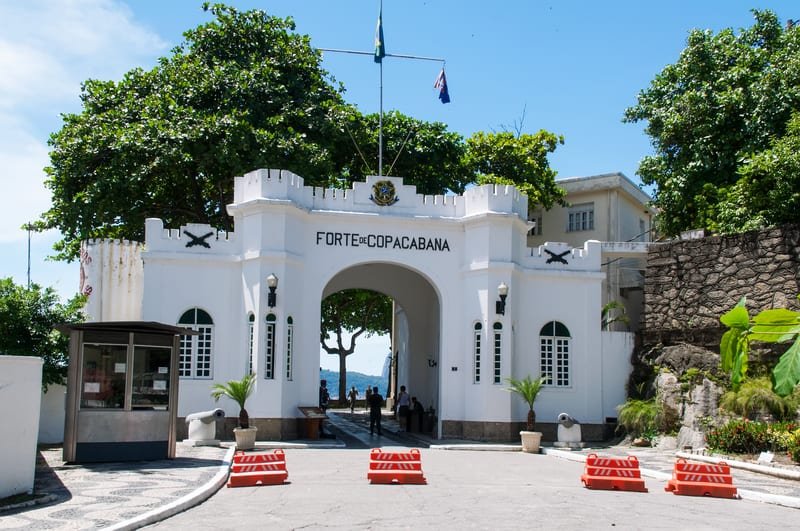
We now have a new YouTube channel! Check out our 101 guide to Copacabana below:
Leisure
Right by the famous Copacabana beach, you’ll be able to visit the Copacabana Fort, which we have briefly discussed in our 6 interesting facts about Copacabana Beach post. The view at the fort allows for some amazing pictures, and you can also grab a bite at the Confeitaria Colombo, a traditional coffee place inside the fort.
If you happen to find the Copacabana beach a little too crowded (especially during the Summer), just head down to the other end of the beach and you’ll get to Leme, a small and charming district attached to Ipanema. The Leme neighborhood also houses the Parque Estadual da Chacrinha, a beautiful green area in which you can relax and enjoy the nature.
Safety
Although also located in the South zone of Rio de Janeiro, Copacabana isn’t as safe as most other neighborhoods in the area. Due to its enormous size and the fact that 4 favelas are surrounding the district, unfortunately, there are still episodes of robberies and pickpocketing.
Stay alert if you decide to stay at the beach after the sun is down, the last time I got robbed at the beach I honestly didn’t even noticed what happened until later on!
Gastronomy
Copacabana houses tons of bars and restaurants, from the upscale Cipriano (located inside the luxurious Belmond Copacabana Palace Hotel) to more simple (but still delicious) establishment, such as Adega Pérola and Galeto Sats.
Now, if you’re looking for worldwide cuisine, don’t worry. You can find the best Arab food at the Istambul and Amir restaurants, eat some delicious Japanese food at Azumi and even taste some Eastern European delicacies at A Polonesa!
Accessibility
Being so big, the Copacabana district is in the route for many buses that transit around Rio de Janeiro’s South Zone, which facilitates the life of those looking to stay near the area. The most common bus lines are TRO3, 2334, 2338, 455, 463, 483, 740D. The neighborhood is also very near Botafogo, another district we’ll get a better look at further topics.
In regards to subway lines, Copacabana has 3 stations: Cardeal Arcoverde, Siqueira Campos and the Cantagalo station.The General Osório station in Ipanema could also come in handy depending on where you’re going, since it is located right at the border between Copacabana and Ipanema.
4. Urca
Urca at a glance
Pros –
Cons – more expensive than most places in town,
Best hotels –
Where to eat –
Where to drink –
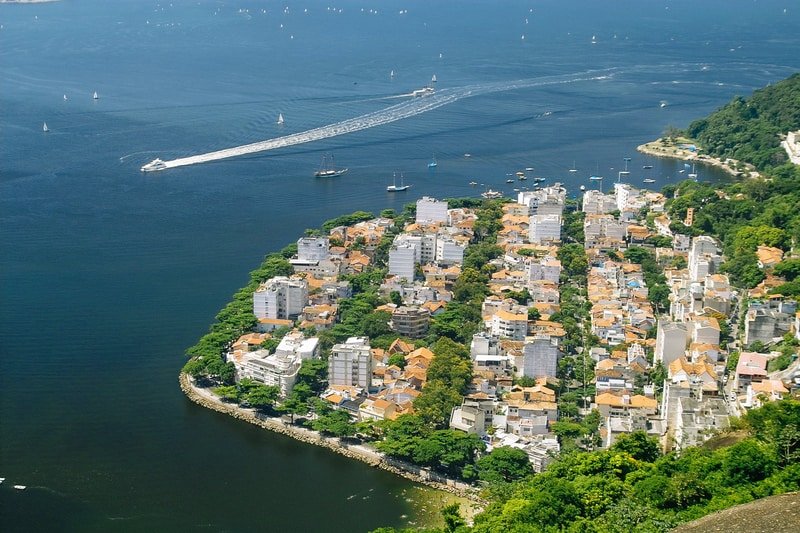
Urca can be best described as a serene little paradise away from the big city. Located in the South Zone of Rio de Janeiro, the Urca neighborhood is very rich in nature, and it is also one of the safest neighborhoods in the city.
Urca also houses a few touristic spots in Rio de Janeiro, like the Sugarloaf, the Morro da Urca mountain, and the Praia Vermelha beach.
Leisure
The main attractions in Urca definetely revolve around the abundant nature in the district. You can go trekking at the Morro da Urca, which is a pretty light walk. At the top, you have two options, you can either take the cable car that goes straight up to the Christ the Redeemer statue, or continue on a harder trail, which involves mountainclimbing as well.
Also, in this next video we also show you how to get to the top of Morro da Urca by trail, without using the cable car! You’ll also be able to see a little bit of what is it like up there, so why not take a quick look?
You can also relax and sunbathe at the small (but very charming) Praia Vermelha, or just walk around the district to see the beautiful houses and architectures. Urca isn’t really a place for parties and night outs, but there are some interesting things to do at night (we’ll get to that a couple of topics ahead).
Safety
Urca is possibly the safest district in Rio de Janeiro for two main reasons: it is located in a very secluded area of the city, where criminals don’t really have anywhere to go in case they get caught stealing or anything of the sort. Besides, there’s a Brazilian Navy HQ in the neighborhood, which means there’s heavier security in the area.
Other than that, Urca isn’t located anywhere near a favela, which is another reason why the criminality rates are considerably lower in this area.
Gastronomy
As we mentioned earlier, Urca isn’t really a reference point when it comes to bars, restaurants and night life, but there are a few nice places you can go to have fun. The Mureta da Urca is definitely the favorite spot in the area, which consists of an outside area facing the Guanabara Bay.
Rio locals love to spend the weekend afternoons at Mureta da Urca, grabbing drinks at the nearest bar (Bar da Urca) and enjoying the beautiful scenery. The Clássico Beach Club and the Garota da Urca restaurant are great choices if you’re looking to have a nice meal.
Other than that, Copacabana and Botafogo are just 15 minutes away by car from Urca, so if you feel like the district is too quiet, you can always head to those places to find something to do.
Speaking of Botafogo, you can find all about it right here in this video:
Accessibility
Getting in and out of Urca isn’t exactly as easy as some other districts in Rio de Janeiro, especially if you’re not driving a car or wishes to use the city’s public transportation. There is only one bus line that crosses Urca (line 107 and, and the neighborhood also doesn’t have a subway station, which makes transiting to other locations a bit more complicated.
There is a bus line integrated with the city’s subway system that goes to Urca (line SP513), but depending on where you’ll be coming from, sometimes it’s best to call in an Uber, as the prices can be pretty competitive (especially if you have more people with you).
5. Gávea
Gávea at a glance
Pros –
Cons – more expensive than most places in town,
Best hotels –
Where to eat –
Where to drink –
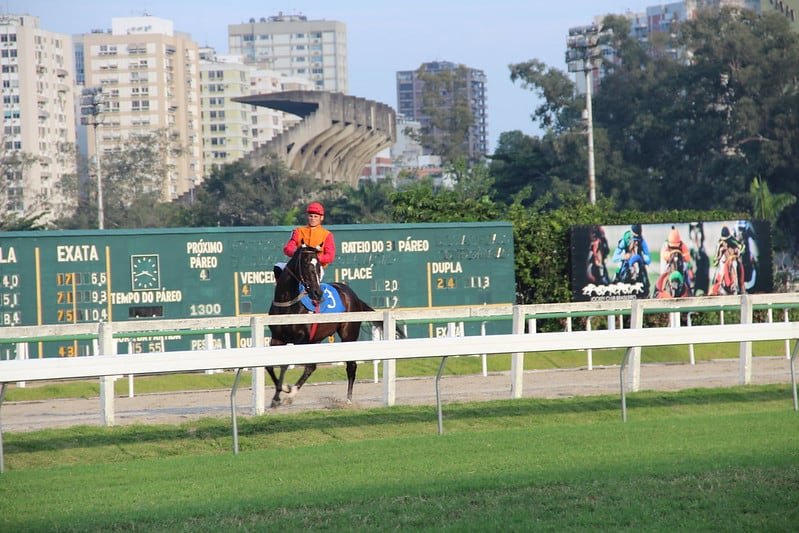
Gávea is another upscale neighborhood located in the South zone of Rio de Janeiro, filled with good restaurants, bars, and cafés. The district is mainly residential and it is very sought by people who want to live in a safer and quieter part of the city.
Leisure
Although small in comparison to other districts in Rio de Janeiro, there’s a lot of interesting things to do around Gávea. The Jóquei Club often attracts tons of people looking to watch horse races (make sure to check on their website in regards to Covid-19 restrictions), and the Gávea Mall is the neighborhood’s main shopping center.
Other than that, you can visit the city’s planetary (Planetário do Rio) to gaze at the stars, watch a movie at Instituto Moreira Sales (which also hosts art exhibitions and cultural performances), or just have a drink at Baixo Gávea, the neighborhood’s gastronomic center.
Safety
Gávea is a very safe neighborhood, much like Leblon. But although it’s pretty common to see police cars around the district, the fact that Gávea is mostly residential makes it a little deserted outside the Baixo Gávea area after a certain hour. So stay alert if you happen to be outside during the night.
Gastronomy
Aside from the delicious restaurants at the Gávea Mall, you can also enjoy many different places in the district. You can have a traditional Brazilian meal at Braseiro da Gávea, some fresh sushis and sashimis at Pe’ahi Temakeria e Sushi Bar or have a traditional Italian pizza at La Pastasciutta.
If you want to have a few drinks, just head to Baixo Gávea and pick one of the many bars around. As a few suggestions, the Brewteco Gávea and BG Bar are two very hyped places in the neighborhood. And if you don’t like any of the places, you could also grab an Uber and head to Leblon, which is just 10 minutes away and has far more options.
Accessibility
Gávea is located in a more difficult area to access, although there are many bus lines that cross the district (like 105 – TRO5, 439, 538, 583, and the integrated bus line with the city’s subway system). Gávea is pretty much in a secluded area inside Rio’s South zone, so you may find yourself somewhat isolated in that region.
Unfortunately, there aren’t any subway lines and stations in Gávea (although that is in the works), and the best way to safely get in and out of the neighborhood would be by Uber.
6. Jardim Botânico
Jardim Botânico at a glance
Pros –
Cons – more expensive than most places in town,
Best hotels –
Where to eat –
Where to drink –

Jardim Botânico is another residential neighborhood located in the South Zone of Rio de Janeiro and it borders with our previous district, Gávea. Jardim Botânico is named after Rio’s Botanical Garden, located at the heart of the neighborhood.
The Botanical Garden is of course, one of the main points of interest in the district (and the city),and you can take a look of what it looks like inside in this video:
Leisure
The Jardim Botânico districted is located right at the feet of the Christ the Redeemer mountain, and houses the beautiful Parque Lage, a famous cultural area in Rio de Janeiro. But truth be said, the Botanical Garden is the true star of the show here, as it is considered one of the richest and most important in the world.
The Botanical Garden also houses the Museum of the Environment (Museu do Meio Ambiente) and the Tom Jobim theater, where many shows take place (check their website to find out more about schedules and Covid-19 restrictions).
And if you happen to visit during the Summer (or during a hot day in Rio), don’t forget to pass by the Horto Waterfall to cool off! My advice is: get there early, as the spot is also pretty famous amongst locals.
Safety
Due to being located in the South Zone of Rio, the Jardim Botânico district is safer than other neighborhoods outside this area. The police force is constantly patrolling the streets, and since Jardim Botânico is surrounded by other safe neighborhoods (Lagoa, Leblon, and Gávea), it’s usually also pretty safe.
But the same advice we gave regarding Gávea also applies here! Jardim Botânico is a very residential neighborhood, and for that reason, the streets get pretty empty and deserted at night. There are usually many police cars around at night (as there are a lot of police blitz for drunk drivers in Rio’s South zone) but still, watch out when you’re out.
Gastronomy
Now, if you want to eat well, Jardim Botânico is the place to go. One of my favorite places is a bistro called La Bicyclette, they have an amazing breakfast menu. There are sandwiches, salads, artisinal bread, it’s really yummy. Another great option to have breakfast at is a place called Empório Jardim, they are both amazing.
For lunch/dinner, there are several cool options to choose from. Prana, for example, is a vegetarian restaurant that will most likely please even non-vegetarians, as the food is absolutely delicious. And for a slice (or a few) of the best natural fermentation pizza, head to Ella Pizzaria and pick one of their amazing toppings!
Accessibility
Just like Gávea, Jardim Botânico is very small, and therefore, there aren’t as many bus lines crossing the district as in some other places (most common lines are (like 105 – TRO5, 439, 538, 583). There are also no subway stations in the neighborhood, but there are integrated buses that can take you to the nearest subway station (in Leblon).
Jardim Botânico is not as isolated as Gávea, being closer to other areas in the city, such as Botafogo and the tunnel that connects Rio’s South Zone to Tijuca (which houses the Maracanã stadium as we’ll see in a further topic).
To move around in the neighborhood, I’d suggest you call an Uber, as this option is safer and innexpensive (since the district is pretty small).
7. Botafogo
Botafogo at a glance
Pros –
Cons – more expensive than most places in town,
Best hotels –
Where to eat –
Where to drink –

Botafogo is one of those areas in which you have a little bit of everything. While some streets are very quiet and residential, others are filled with bars and small pubs. The nightlife in Botafogo is one of the most democratic in the city, as many types of public are able to find cool places to have fun.
Although very big, you are still able to do a lot by foot around Botafogo, as there are always markets, drugstores, and other establishments within walking distance. Botafogo is one of my favorite neighborhoods in the city, as it allows for all kinds of activities!
Leisure
If you’re looking for some outside activities, the Botafogo beach is a nice place to exercise, although the water is unfortunately not proper for bathing. You could also head to the Pasmado Observatory (Mirante do Pasmado) for some amazing pictures, as its view of the bay is pretty impressive.
The district also houses some very cool cultural spaces, such as the Estação NET, one of the very few street movie theaters that has survived in Rio de Janeiro. Aside from the usual latest releases, the theater also exhibits some more indie films, so make sure to keep an eye on their schedule.
Another nice place to visit is Casa Rui Barbosa, a historical spot that serves as a museum, research center, and a conservation and educational unit. And if you’re looking for something a little different, there are always art exhibitions at the Comuna, a very hype bar/cultural space in which you can have delicious drinks and one of the best burgers in the city.
Safety
Although also located in the South zone of Rio de Janeiro, Botafogo isn’t as safe as most other neighborhoods in the area. Some streets are pretty dark and deserted at night, and since the district is very big, I feel like there aren’t as many police cars around as it should.
Still, the neighborhood is usually pretty safe, especially during the day. At night, stay close to the crowded areas as you should be just fine.
Gastronomy
Botafogo is a BIG gastronomic area in Rio de Janeiro, where many people go due to the many options in regards to bars and restaurants. There is always something new, like the Be+Co space. It is essentially a villa of restaurants, in which you can sit to sip a few drinks and/or eat one of the many options on the menus.
Another interesting place to go to is the CoLAB restaurant, as it is a great option for either breakfast, lunch, or dinner! In the morning, they serve an amazing grilled cheese on the sourdough bread. At lunch, I’ve once had an avocado salad that was to die for, and at night, there are drinks, live music, and delicious appetizers! The place also houses art exhibitions from time to time.
Accessibility
Botafogo is located in a very privileged spot in Rio’s South zone, as not only is it very close to the other districts in the area (Copacabana, Flamengo, Lagoa, Jardim Botânico) but also near Rio’s downtown area. So if you want to enjoy a little bit of everything in Rio, Botafogo is a very nice place to stay in.
There are several bus lines that cross the neighborhood ( such as 309, 3721D, 548 – INT3, 9721D), and some of them are integrated with the subway, making it easier to access districts like Gávea and Jardim Botânico). Botafogo also houses the Botafogo subway station, making it even easier to access other parts of the city using safer public transportation.
8. Flamengo
Flamengo at a glance
Pros –
Cons – more expensive than most places in town,
Best hotels –
Where to eat –
Where to drink –

Flamengo is another district located in the South zone of Rio de Janeiro, bordering 2 other very nice districts, Botafogo and Humaitá. This very small neighborhood (my favorite in the whole city) has everything you need within a walking distance and it’s also very close to accessing other parts of the city (the North zone and the city’s Downtown area).
Leisure
The Aterro do Flamengo is one of the highlights of this district. It is a large green area filled with sports courts, bike and rollerblade lanes, skate ramps and a beautiful view to the Guanabara Bay. It’s a great place to have a picnic or take the kids to play while soaking up the sun.
Although small, the Flamengo district also houses a few cultural spaces, such as the Oi Futuro modern museum, and also some historical sites, like Republic Museum and the Palácio do Catete. The architecture at the district’s shoreline is very beautiful, especially the Castelinho do Flamengo building.
You can check all these attractions and more on our Flamengo 101 Guide video, right here:
Safety
Just like its neighbor Botafogo, Flamengo is kind of a mixed bag in regards to safety. It is indeed safer than other neighborhoods outside Rio de Janeiro’s South Zone, but it still can be a bit dangerous around the more residential streets, as the lack of establishments and larger crowds facilitate the action of thieves and robbers.
The Aterro do Flamengo is a well-known area where people constantly get mugged or robbed during the night, so that I wouldn’t advise going to Aterro do Flamengo after the Sun is set. Even during the daytime, stay alert in less-crowded areas, as you could potentially be approached by speed robbers on bikes.
Still, the neighborhood is overall pretty safe, especially during the daytime, when there is police force making rounds.
Gastronomy
Flamengo may not have as many options as Botafogo in terms of bars and restaurants, but it still has enough places to keep you satisfied. If you’re in the mood to have a couple of drinks , the São Salvador square is a well-known place for locals, where you can have a beer while enjoying the outside wheather.
Other than that, Le Vin Bistrô & Patisserie is a great place to have breakfast or a cup of coffee in the afternoon, and the Panka restaurant is a favorite for Spanish and Peruvian cuisine lovers. The Lamas restaurant is a staple in the neighborhood, being active for over 40 years now.
Accessibility
Like Botafogo, Flamengo is located in a very privileged spot in Rio’s South Zone, as not only is it very close to the other districts in the area (Copacabana, Lagoa, and Jardim Botânico) but also near Rio’s downtown area. So if you want to enjoy a little bit of everything in Rio de Janeiro, Flamengo is also a very nice place to stay in.
There aren’t as many bus lines that cross the neighborhood (due to Flamengo being a bit small), the main ones being 2740D (EXECUTIVO), 309, 410, 433, 583, and 740D. Also, some of the bus lines are integrated with the subway, making it easier to access districts like Gávea and Jardim Botânico).
Flamengo also houses the Flamengo subway station, making it even easier to access other parts of the city using safer public transportation.
9. São Conrado
São Conrado at a glance
Pros –
Cons – more expensive than most places in town,
Best hotels –
Where to eat –
Where to drink –
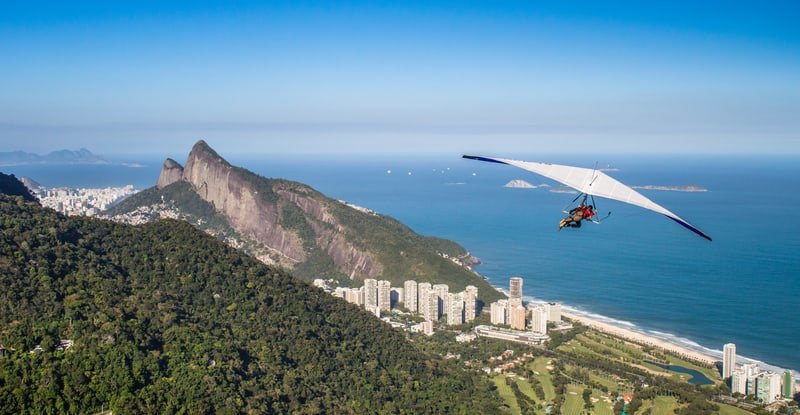
Located right in the middle of the Barra da Tijuca district and Rio de Janeiro’s South Zone, São Conrado is a well-known region for its tall buildings and for housing the Pedra da Gávea mountain, where many people like to skydive and parachute from.
The São Conrado district is visually very contrasting, as on one side you have the beautiful and luxurious buildings and houses, and on the other, you have the Rocinha slum, the biggest favela Carioca (if you don’t know what that means, take a look at this post).
Leisure
Aside from the beautiful São Conrado beach, there are many other outdoor activities you can do in the neighborhood. As we mentioned before, the Pedra Bonita mountain is a famous spot for skydiving and parachuting, and the Mirante do Joá Observatory is a great place to get a privileged view of the city (as well as take a few pictures).
The neighborhood also houses the Fashion Mall, an upscale shopping mall that allows pets inside, aside from having a VIP movie theater and a regular theater for plays and concerts. São Conrado also has many membership clubs, such as Costa Brava, in which you can pay a daily fee to spend the day at their pools and dependencies, like the club’s own private beach.
Safety
Being located so near the Rocinha favela is definitely something that worries both residents and visitors. Due to the fact that there ain’t much you can do here without depending on a car or Uber, there aren’t many reports in regards to robbers and thieves around the district.
But the ocasional shootings and confrontations between the Rocinha drug dealers and the Police is the most worrying aspect of being here, especially if you’re staying nearer the slum.
Gastronomy
São Conrado isn’t really known for its night life and gastronomy options, but the district does have a few really good places you can go to grab a drink or a meal. If you’re in the mood for something a little more outdoorsy, the Barthô Praia kyosk and Qui Qui São Conrado are excellent choices, providing you with the full gourmet beach experience.
Other than that, the Fashion Mall houses the majority of restaurants in São Conrado, like the delicious Gurumê (famous for its always fresh Japanese buffet), the Brasero Atlântico restaurant (which has the best seafood in the district), and Chez L’Ami Martin, which especializes in French cuisine.
Accessibility
Getting in and out of São Conrado has become considerably easy ever since the district inaugurated it’s own subway station (the São Conrado/Rocinha station), making it easier for people to access the neighborhood. There are also a few bus lines that pass through São Conrado (such as 181, 309, 548 – INT3, 558 – INT6, 565), since the district connects Rio’s South Zone to Barra da Tijuca.
To get around in São Conrado, I would advise to either take the subway or an Uber, as both options are safer than getting on a bus in Rio de Janeiro.
10. Barra da Tijuca
Barra da Tijuca at a glance
Pros –
Cons – more expensive than most places in town,
Best hotels –
Where to eat –
Where to drink –
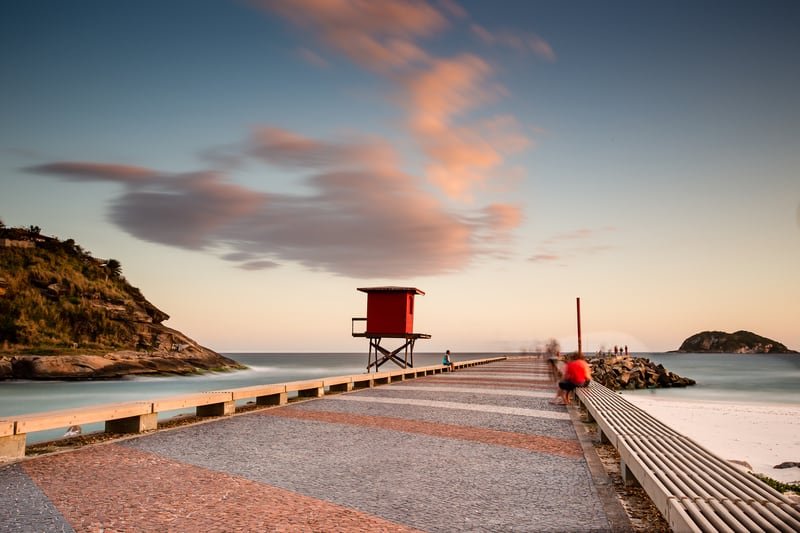
Barra da Tijuca is a big neighborhood located in the West Zone of Rio de Janeiro, and like Botafogo, you’ll find a little bit of everything there. Barra da Tijuca is very famous for its beautiful beach and for housing the biggest shopping mall in Rio, called Barra Shopping.
There are also great restaurants and entertainment centers around the district, as well as movie theaters, open shopping malls and clubs.
Leisure
The whole coast of Barra da Tijuca is excelent for swimming and sunbathing, especially since the beaches here are less crowded than the ones in the South Zone of Rio de Janeiro. The main ones you should visit are the Joatinga beach (where the sand strip is narrow to the point it disappears during the high tide), the Pepê beach (one of the most hyped), and the Reserva beach, which is the furthest of them all.
The many shopping malls are also highlights in Barra da Tijuca, especially the Barra Shopping (the main shopping center of the district) and the Village Mall, a luxurious complex of international stores and high-end retailers.
Safety
Barra da Tijuca is a very safe neighborhood to stay or live in Rio de Janeiro. There are always police cars making rounds around the district, so it’s ok to go out without worrying too much about safety, even at night.
The fact that there’s little you can do in Barra da Tijuca by foot also reduces the criminality rates, just be careful when you stop at red lights, as there are occasional cases of robbers on motorcycles looking to rob distracted drivers.
Gastronomy
Being so big, it’s no wonder that Barra da Tijuca is one of the main gastronomic centers in Rio de Janeiro. Aside from the many options you’ll find by entering the several shopping malls around Barra, you also have some very nice and sophisticated places in the district.
For example, the Parque das Rosas complex is a famous conglomerate of bars and pubs, which a lot of people go to have a few drinks before hitting the night. Inside the Downtown shopping mall (which is an open air mall), there are also a lot of establishments of the same sort, which are great options to have if you like to stay outside like myself.
But if you’re looking for a place to eat with more confort, the Jardim Oceânico area in Barra da Tijuca houses plenty places for you to choose from, like seafood restaurant Porto Frescatto, Italian parlor Mamma Mia Rio and Japanese place Sushi Carioca.
Accessibility
One of the main issues I have with Barra da Tijuca is the fact that it is located pretty far away from the rest of the city, especially Rio de Janeiro’s Downtown area. Depending on where you are in Barra, it will take you at least half an hour by car to get to the South Zone or any other region in the city.
So if you’re planning on visiting a lot of places somewhat distant from Barra da Tijuca, I would suggest staying at a location nearer to your points of interest, as traffic can get pretty intense in Barra sometimes.
Regarding public transportation, the district has one subway station (Jardim Oceânico station), and there are several bus lines that go around the neighborhood, like 2334, 35A, 548 – INT3, 553 – INT8, 565, 863, and 900.
11. Recreio dos Bandeirantes
Recreio dos Bandeirantes at a glance
Pros –
Cons – more expensive than most places in town,
Best hotels –
Where to eat –
Where to drink –
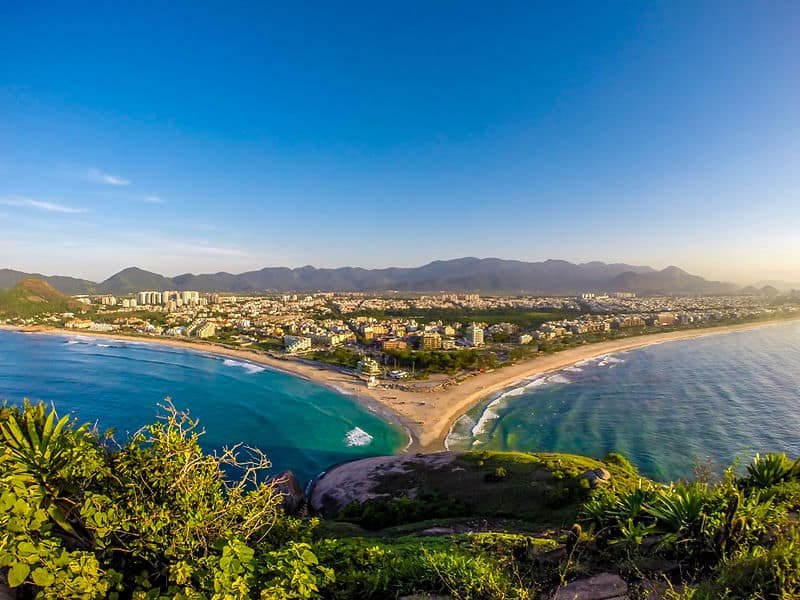
Bordering Barra da Tijuca, you will find the Recreio dos Bandeirantes district, a place where people looking to live away from the urban centers but still want to have plenty of infrastructures go to live.
Leisure
Talvez o principal ‘carro-chefe’ do bairro. Praias do Recreio, Pontal, Macumba, Prainha e Grumari (que se estendem nesta ordem) são boas opções para os banhistas. Inclusive, é muito comum entre os frequentadores da região subir a Pedra do Pontal, de fácil acesso.
Além delas, há também Abricó, espaço destinado a quem gosta da prática do nudismo localizado entre a Prainha e Grumari, e a Praia do Secreto, uma espécie de ‘piscina’ de água salgada formada entre a Macumba e a Prainha. É muito procurada por turistas.
O Recreio possui 2 importantes espaços ecológicos da cidade. Trata-se dos Parques Naturais Municipais de Marapendi e o Chico Mendes. Outra boa opção que tanto um quanto o outro parque oferecem são os playgrounds destinados ao público infantil, que contam com brinquedos em bom estado de conservação, e os locais destinados à realização de piqueniques, para toda a família.
Safety
Localizado também na Zona Oeste, O Recreio possui um clima mais residencial e acolhedor, o bairro é muito conhecido pela excelente qualidade de vida que é possível ter no local, que é visto também como uma opção bastante viável no quesito segurança.
Gastronomy
Outra possibilidade de diversão no bairro são os bares. Na área da popular Praça da Zefa. No Brooks Pub, espaço fechado onde ouve-se boas bandas de rock num ambiente bem ‘europeu’, há mesas de sinuca e mais de 80 opções de cervejas nacionais e importadas.
Já no Alcarnes Grill & Bar e no Premium Carnes, que ficam localizados um em frente ao outro, o cliente pode escolher a peça que quer comer direto na geladeira e mandar fazer. Além deles, tem também o Zefa’s Bar, o ‘queridinho’ da região, com o preço de cerveja mais barato.
Para quem gosta de comida nordestina, o Restaurante Kaçuá, na Rua Senador Rui Carneiro, é a boa. Com várias opções de comidas típicas do Nordeste brasileiro, fica como sugestão principal o croquete de carne de sol.
Accessibility
Just like with Barra da Tijuca, one of the main issues I have with Recreio dos Bandeirantes is the fact that it is located pretty far away from the rest of the city, even further than Barra. Of course, having Barra da Tijuca as a neighbor is definetely a plus, but it’s still almost an hour away from Rio de Janeiro’s downtown area.
So if you’re planning on visiting a lot of places somewhat distant from Barra da Tijuca and Recreio dos Bandeirantes, I would suggest staying at a location nearer to your points of interest, as traffic can get pretty intense sometimes.
The district does not have a subway station, but you can take integrated bus lines to Recreio that departure from the Jardim Oceânico station in Barra da Tijuca.
12. Tijuca
Tijuca at a glance
Pros –
Cons – more expensive than most places in town,
Best hotels –
Where to eat –
Where to drink –
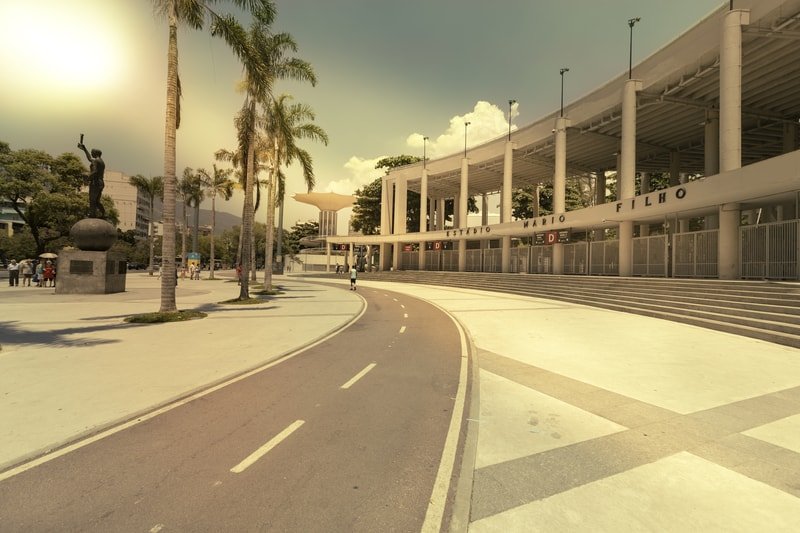
Tijuca is the district famous for housing the Maracanã stadium and the only neighborhood on the North Zone of Rio de Janeiro to make on our list. It’s one of the oldest and most traditional naighborhoods in the city, being also one of the largest.
The Tijuca district is well-known for having an agitated night life, as well as for having some very nice locations if you’re looking to do outside activities in the nature.
Leisure
Aside from the Maracanã stadium, Tijuca also houses another pretty cool attraction, the Tijuca Forest, one of the biggest urban green areas in the world. The forest is an excelent place for trekking, riding your bike, jogging and even mountain climbing.
We made a very cool video showing around the Tijuca Forest, so take a look if you want to see one of the most beautiful areas in Rio:
Tijuca is also very close to another district called Grajaú, where there’s another important green area in Rio de Janeiro, the Grajaú State Park (Parque Estadual do Grajaú).
The Tijuca Mall is the main shopping center of the Tijuca district, but the neighborhood also houses several other mini malls and street stores if you should need to purchase anything. Oh, some samba schools like Acadêmicos do Salgueiro and Unidos da Tijuca are also located in Tijuca, so try to find out if they’re having ay rehearsals, they’re always pretty fun to watch!
Safety
Unfortunatelly, the Tijuca district isn’t one of the safest neighborhoods in Rio de Janeiro, although it is probably the safest in the North Zone of the city. There are several favelas surrounding the district, which sometimes can be dangerous for people passing by.
Tijuca doesn’t suffer as much from other public disorder issues like drug addicts and homeless people as it does with criminality issues, but police force has been heavily reinforced in the area since 2020, which has been reflecting in less episodes of theft.
Gastronomy
Praça Varnhagen. A praça abriga o polo gastronômico da Tijuca, um conjunto de bares e restaurantes com as mais diversas opções de diversão nos fins de semana. Além de uma praça para leitura, entre outros programas.
Falar Momo, Wursteria e restaurantes no shopping.
Accessibility
O transporte do bairro fica por conta de inúmeras linhas de ônibus e a linha 1 do metrô: Afonso Pena, São Francisco Xavier, Saens Peña e Uruguai. É a região com mais estações de metrô no Rio de Janeiro, além das várias ciclofaixas que estão sendo construídas.
Since Tijuca is the main connection between Rio’s North Zone to the South area of the city, there are several bus lines that crosses the neighborhood, such as 239, 301, 302, 415, 433, 439, 607, and 750D.
sua localização privilegiada lhe confere fácil acesso tanto à Zona Sul como ao Centro da cidade.
Neighborhoods To Avoid in Rio de Janeiro
As most people know, Rio de Janeiro is not exactly known to be a safe city for either locals or tourists. The aforementioned neighborhoods are mostly touristic places in which the City Hall invest a lot of money in order to keep them safe and clear of troubles, but there are a lot of districts in which you should be careful.
Quando dizemos que alguma parte da cidade é mais perigosa ou mais segura que outra, estamos nos apoiando nos dados fornecidos mensalmente pela IPS-Rio.
O que chamamos popularmente de “índice de criminalidade” tem a nomenclatura oficial de “taxa de delito”. Essa estatística é de fundamental importância para a implementação de políticas de segurança e costuma ser muito usada no mercado imobiliário também. Afinal, as taxas de ocorrência de crimes pode ser um dos melhores indicadores sobre a viabilidade de investimentos em uma região da cidade.
Ainda seguindo a lógica da taxa de delitos, é possível fazer um mapeamento sobre as áreas mais violentas da cidade. De acordo com os últimos levantamentos oficiais, a região Sul tem se mostrado como a zona mais perigosa de SP.
Um levantamento do Instituto Sou da Paz mostrou que, dos dez bairros mais violentos da capital, quatro estão na zona Sul. A organização criou um ranking para monitorar a exposição dos moradores a crimes violentos.
Méier (66,37), Centro (65,05), Ilha do Governador (64,70), Penha (61,76), Irajá (61,76), Inhaúma (60,9), Santa Teresa (60,7) e Jacarepaguá (60,09); e o com IPS entre 50 e 59: Ramos (57,75), Campo Grande (57,18), Anchieta (56,95), Bangu (54,73), Realengo (54,32), Madureira (53,85), Rio Comprido (53,52), Vigário Geral (53,03), Maré (52,34) e São Cristóvão (52,09).
So, how did you like our guide through the best neighborhoods in Rio de Janeiro? Aside from beautiful, the city houses many safe and cool neighborhoods to stay at, so it’s just a matter of finding which one fits your budget and interests best. The city’s infrastructure is constantly evolving, so you’ll definitely be in for a treat if you decide to visit Rio de Janeiro!
While you’re here, I think we might interest you with these:
Is Rio Expensive? Go To These Places Instead – Is Rio too expensive for your budget right now? Don’t worry, we won’t let that ruin your vacation! Click here and take a look at some other amazing destination choices!
Where To Go From Rio: 19 Places for Amazing Short Trips – Now that you’ve visited the city of wonders, how about touring some of the cities nearby?
Swimming In Rio Beaches: The Do’s And Don’t’s – Thinking about hitting the beach in Rio de Janeiro? Well, then take a look at this post, as we have some info that might interest you before you dive into the waters!
Cover Image: Aerial view of the Rodrigo de Freitas Lagoon in Rio de Janeiro – Credit: ID 68517141 © Ekaterinabelova | Dreamstime.com

